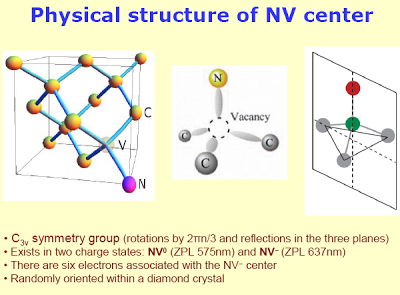Nanosystems Initiative Munich – A method for manipulating the charge of nitrogen vacancy-centres in diamond – which are thought to be important areas in the creation of qubits in quantum computers – is reported in Nature Communications this week. The approach, which relies on the use of electrolytes similar to those used in batteries, is a step towards achieving more practical realizations of quantum computers.
Electron spins at nitrogen vacancy-centres in diamond are thought to be promising candidates for qubits in quantum computers. However, their unstable charge states are an obstacle to their successful use in large-scale quantum processors. Jose Garrido and colleagues present a method for manipulating the charge state of nitrogen vacancies using an electrolytic gate electrode. By applying a voltage through the electrolyte, they are able to reliably control the spin state of the centres. Because of their potential as qubits, these results could have important implications for quantum computing.
Nature Communications – Charge state manipulation of qubits in diamond
The nitrogen-vacancy (NV) centre in diamond is a promising candidate for a solid-state qubit. However, its charge state is known to be unstable, discharging from the qubit state NV− into the neutral state NV0 under various circumstances. Here we demonstrate that the charge state can be controlled by an electrolytic gate electrode. This way, single centres can be switched from an unknown non-fluorescent state into the neutral charge state NV0, and the population of an ensemble of centres can be shifted from NV0 to NV−. Numerical simulations confirm the manipulation of the charge state to be induced by the gate-controlled shift of the Fermi level at the diamond surface. This result opens the way to a dynamic control of transitions between charge states and to explore hitherto inaccessible states, such as NV+.
In conclusion, we have shown that an electrical manipulation of the charge state of shallow implanted NV centres below hydrogenated diamond surfaces is possible by using an external gate electrode. Ensembles of NV centres can be switched reversibly between NV0 and NV− by the gate voltage, whereas the charge state of single NV centres can be switched between positive and neutral. Numerical simulations, modelling the effect of the gate electrode on the diamond band structure, provide a quantitative description of the experimental results. These findings offer a first way to reversibly control the charge state of the NV centres in an extremely versatile manner, providing an important tool for the use of single NV centres for diamond-based spintronics or sensing applications. Furthermore, our results open the way to study formerly unstable or unknown charge states like NV0 and the positively charged NV+, for which several applications have already been proposed.
Background and other research
Nextbigfuture covered other work on getting more control over nitrogen vacancies.
Here is a 44 page paper about Nitrogen Vacancies and their applications.
Nitrogen-vacancy (NV) centers in diamond: basic properties and applications
* World diamond consumption was about 800 tonnes in 2006
Applications are to use them for in sensing and measuring things more precisely and for future quantum information processing.
NV center attributes
1. Optically induced spin polarization
2. Optical detection of ground state spin
3. Paramagnetic ground state (S = 1)
4. Long spin lifetimes T2 ~ 2 ms at room temperature
5. Possibility to address single center
6. Operating temperature range (LHe-300+ K)
7. Spatial resolution (~ 1 nm)
8. Intrinsic scalability (nm – mm)
This thesis presents works not only to understand the spin degree of freedom
present in the nitrogen-vacancy defect in diamond: its internal structure and its relation to its environment, but also to find novel applications of it in metrology. First, a mathematical model is develop to understand how this defect couples to a nuclear spin bath of Carbon 13 which constitutes the main dephasing mechanism in pure natural diamond. Next, we demonstrate the use of this defect to sense external oscillating magnetic fi elds. The high sensitivity and the small sensing volume achieved when a defect is placed in a nanocrystal of few tents of nanometers in diameter, allows this sensor to detect single electronic spins and even single nuclear spins. This sensitivity, proportional to the signal to noise per readout, can be improve by the help of the environment of this defect. We show that strongly interacting nearby nuclei can enable repetitive readout schemes to improve the signal to noise of the electronic spin signal. We also combine ideas from the microscopy community such as stimulated emission depletion to enable high spatial resolution magnetometry. Finally, we develop a formalism based on group theory to understand the internal structure of defects in solids such as their selection rules and the eff ect of spin-spin and spin-orbit interactions even when perturbations reduce the symmetry group of the system.
If you liked this article, please give it a quick review on ycombinator or StumbleUpon. Thanks

Brian Wang is a Futurist Thought Leader and a popular Science blogger with 1 million readers per month. His blog Nextbigfuture.com is ranked #1 Science News Blog. It covers many disruptive technology and trends including Space, Robotics, Artificial Intelligence, Medicine, Anti-aging Biotechnology, and Nanotechnology.
Known for identifying cutting edge technologies, he is currently a Co-Founder of a startup and fundraiser for high potential early-stage companies. He is the Head of Research for Allocations for deep technology investments and an Angel Investor at Space Angels.
A frequent speaker at corporations, he has been a TEDx speaker, a Singularity University speaker and guest at numerous interviews for radio and podcasts. He is open to public speaking and advising engagements.



